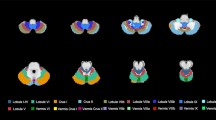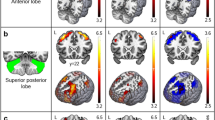Abstract
This study sought to characterise force variability and motor overflow in 12 individuals with Friedreich ataxia (FRDA) and 12 age- and gender-matched controls. Participants performed a finger-pressing task by exerting 30 and 70 % of their maximum finger force using the index finger of the right and left hand. Control of force production was measured as force variability, while any involuntary movements occurring on the finger of the other, passive hand, was measured as motor overflow. Significantly greater force variability in individuals with FRDA compared with controls is indicative of cortico-cerebellar disruption affecting motor control. Meanwhile, significantly greater motor overflow in this group provides the first evidence of possible abnormal inter-hemispheric activity that may be attributable to asymmetrical neuronal loss in the dentate nucleus. Overall, this study demonstrated a differential engagement in the underlying default processes of the motor system in FRDA.




Similar content being viewed by others
References
Pandolfo M (2009) Friedreich ataxia: the clinical picture. J Neurol 256:3–8
Delatycki MB, Williamson R, Forrest SM (2000) Friedreich ataxia: an overview. J Med Genet 37:1–8
Murayama S, Bouldin TW, Suzuki K (1992) Pathological stuffy of corticospinal-tract degeneration in Friedreich’s ataxia. Neuropathol Appl Neurobiol 18:81–86
Hou JG, Jancovic J (2003) Movement disorders in Friedreich’s ataxia. J Neurol Sci 206:59–64
Delatycki MB, Paris D, Gardner RJ, Nicholson GA, Nassif N, Storey E et al (1999) Clinical and genetic study of Friedreich ataxia in an Australian population. Am J Med Genet 87:168–174
Corben LA, Tai G, Wilson C, Collins V, Churchyard A, Delatycki M (2010) A comparison of three measures of upper limb function in Friedreich’s ataxia. J Neurol 257(4):523–528
Epstein E, Farmer J, Tsou A, Perlman S, Subramony SH, Gomez CM et al (2008) Health related quality of life in Friedreich’s ataxia. J Neurol Sci 272:123–128
Brownell B, Oppenheimer DR, Hughes JT (1970) The central nervous system in motor neuron disease. J Neurol Neurosurg Psychiatry 41:287–410
Akhlaghi H, Corben L, Georgiou-Karistianis N, Bradshaw J, Delatycki M, Egan G A functional MRI study of motor dysfunction in Friedreich’s ataxia. Brain Res (in press)
Corben LA, Delatycki MB, Bradshaw JL, Horne MK, Fahey MC, Churchyard AJ, Georgiou-Karistianis N (2010) Impairment in motor reprogramming in Friedreich ataxia reflecting possible cerebellar dysfunction. J Neurol 257(5):782–791
Corben LA, Akhlaghi H, Georgiou-Karistianis N, Bradshaw JL, Egan GF, Storey E, Delatycki M (2011) Impaired inhibition of prepotent motor tendencies in Friedreich ataxia demonstrated by the Simon interference task. Brain Cogn 76:140–145
Corben LA, Delatycki MB, Bradshaw JL, Churchyard AJ, Georgiou-Karistianis N (2011) Utilisation of advance motor information is impaired in Friedreich ataxia. Cerebellum 10(4):793–803
Brighina F, Scalia S, Gennuso M, Lupo I, Matta F, Piccoli T et al (2005) Hypoexcitability of cortical areas in patients affected by Friedreich ataxia: a TMS study. J Neurol Sci 235:19–22
Courchesne E, Allen G (1997) Predicting and preparation, fundamental functions of the cerebellum. Learn Mem 4:1–35
Della Nave R, Ginestroni A, Tessa C, Salvatore E, Bartolomei I, Salvi F et al (2008) Brain white matter tracts degeneration in Friedreich ataxia: an in vivo MRI study using tract-based spatial statistics and voxel-based morphometry. Neuroimage 40(1):19–35
Middleton FA, Strick PL (2000) Basal ganglia and cerebellar loops: motor and cognitive circuits. Brain Res Rev 31:236–250
Georgiou-Karistianis N, Akhlaghi H, Corben LA, Delatycki M, Storey E, Bradshaw JL, Egan G (2012) Decreased functional brain activation in Friedreich ataxia using the Simon interference task. Brain Cogn 79:200–208
Ginestroni A, Diciotti S, Cecchi P, Pesaresi I, Tessa C, Giannelli M et al (2012) Neurodegeneration in Friedreich’s ataxia is associated with a mixed activation pattern of the brain. A fMRI study. Hum Brain Mapp 33:1780–1791
Armatas CA, Summers JJ, Bradshaw JL (1994) Mirror movements in normal adult subjects. J Clin Exp Neuropsychol 16(3):405–413
Armatas CA, Summers JJ, Bradshaw JL (1996) Strength as a factor influencing mirror movements. Hum Mov Sci 15:689–705
Armatas CA, Summers JJ, Bradshaw JL (1996) Handedness and performance variability as factors influencing mirror movement occurrence. J Clin Exp Neuropsychol 18(6):823–835
Abercrombie M, Lindon R, Tyson M (1964) Associated movements in normal and physically handicapped children. Dev Med Child Neurol 6:573–580
Addamo PK, Farrow M, Hoy KE, Bradshaw JL, Georgiou-Karistianis N (2009) The influence of task characteristics on younger and older adult motor overflow. Quart J Exp Psychol 62(2):239–247
Cohen HJ, Taft TT, Mahadeviah MS, Birch HG (1967) Developmental changes in overflow in normal and aberrantly functioning children. J Pediatrics 71:39–47
Conolly K, Stratton P (1968) Developmental changes in associated movements. Dev Med Child Neurol 10:49–56
Nass R (1985) Mirror movement asymmetries in congenital hemiparesis: the inhibition hypothesis revisited. Neurology 35:1059–1062
Addamo PK, Farrow M, Hoy KE, Bradshaw JL, Georgiou-Karistianis N (2007) The effects of age and attention on motor overflow production—a review. Brain Res Rev 54:189–204
Espay AJ, Li J-Y, Johnston L, Chen R, Lang AE (2005) Mirror movements in Parkinsonism: evaluation of a new clinical sign. J Neurol Neurosurg Psychiatry 76:1355–1359
Georgiou-Karistianis N, Hoy KE, Bradshaw JL, Farrow M, Chiu E, Churchyard A et al (2004) Motor overflow in Huntington’s disease. J Neurol Neurosurg Psychiatry 75:904–906
Hoy KE, Fitzgerald PB, Bradshaw JL, Armatas CA, Georgiou-Karistianis N (2004) Investigating the cortical origins of motor overflow. Brain Res Rev 46:315–327
Dennis M (1976) Impaired sensory and motor differentiation with corpus callosum agenesis: a lack of callosal inhibition during ontogeny? Neuropsychologia 14:455–469
Muller F, Kunesch E, Binkofski F, Freund HJ (1991) Residual sensorimotor functions in a patient after right sided hemispherectomy. Neuropsychologia 29:125–145
Addamo PK, Farrow M, Hoy KE, Bradshaw JL, Georgiou-Karistianis N (2009) A developmental study of the influence of task characteristics on motor overflow. Brain Cogn 69:413–419
Baliz Y, Armatas C, Farrow M, Hoy KE, Fitzgerald PB, Bradshaw JL, Georgiou-Karistianis N (2005) The influence of attention and age on the occurrence of mirror movements. J Int Neuropsychol Soc 11:855–862
Hoy KE, Fitzgerald PB, Bradshaw JL, Farrow M, Brown TL, Armatas CA, Georgiou-Karistianis N (2004) Motor overflow in schizophrenia. Psychiatry Res 125:129–137
Subramony SH, May W, Lynch D, Gomez C, Fischbeck K, Hallett M et al (2005) Measuring Friedreich ataxia: interrater reliability of a neurologic rating scale. Neurology 64:1261–1262
Morris S (2002) Ashworth and Tardieu scales: their clinical relevance for measuring spasticity in adult and paediatric neurological populations. Phys Ther Rev 7:53–62
Grice KO, Vogel KA, Le V, Mitchell A, Muniz S, Vollmer MA (2003) Adult norms for a commercially available nine hole peg test for finger dexterity. Am J Occup Ther 57:570–573
Beck AT, Ward CH, Mendelson M, Mock J, Erbaugh J (1961) An inventory for measuring depression. Arch Gen Psychiatry 4:561–571
Oldfield RC (1970) The assessment and analysis of handedness: the Edinburgh inventory. Neuropsychologia 9:97–113
Corben LA, Georgiou-Karistianis N, Fahey MC, Storey E, Churchyard A, Horne M et al (2006) Towards an understanding of cognitive function in Friedreich ataxia. Brain Res Bull 70:197–202
Ito M (2008) Control of mental activities by internal models in the cerebellum. Nat Rev Neurosci 9(4):304–313
Rizzo G, Tonon C, Valentino ML, Manners D, Fortuna F, Gellera C et al (2011) Brain diffusion-weighted imaging in Friedreich’s ataxia. Mov Disord 26(4):705–712
Sehm B, Perez MA, Xu B, Hidler J, Cohen LG (2010) Functional neuroanatomy of mirroring during a unimanual force generation task. Cereb Cortex 20:34–45
Habas C, Cabanis EA (2006) Cortical areas functionally linked with the cerebellar second homunculus during out-of-phase bimanual movements. Neuroradiology 48(4):273–279
Doya K (2002) Complementary roles of basal ganglia and cerebellum in learning and motor control. Curr Opin Neurobiol 10:732–739
Minzenberg MJ, Yoon JH, Soosman SK, Carter CS (2012) Excessive contralateral motor overflow in schizophrenia measured by fMRI. Psychiatry Res 202:38–45
Addamo PK, Farrow M, Bradshaw JL, Moss S, Georgiou-Karistianis N (2010) The effect of attending to motor overflow on its voluntary inhibition in young and older adults. Brain Cogn 74:358–364
Acknowledgments
We would like to thank all participants for taking part in our research. MBD is a NHMRC Practitioner Fellow. This research was funded by the School of Psychology and Psychiatry, Monash University.
Conflicts of interest
The authors declare that they have no conflict of interest.
Author information
Authors and Affiliations
Corresponding author
Rights and permissions
About this article
Cite this article
Low, SC., Corben, L.A., Delatycki, M.B. et al. Excessive motor overflow reveals abnormal inter-hemispheric connectivity in Friedreich ataxia. J Neurol 260, 1757–1764 (2013). https://doi.org/10.1007/s00415-013-6869-3
Received:
Revised:
Accepted:
Published:
Issue Date:
DOI: https://doi.org/10.1007/s00415-013-6869-3




